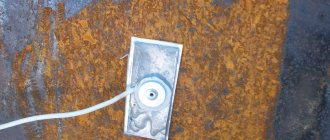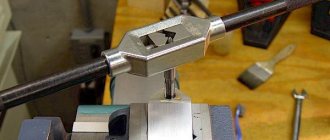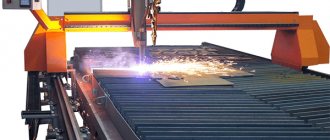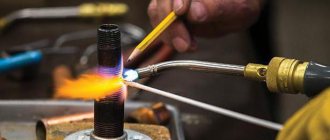When designating products, for example, a copper pipe with a diameter of 8 mm, we mean one of the main parameters of pipes - the outer diameter. Many properties of the future pipeline (working pressure, length, etc.) depend on this indicator. It is necessary to be able to operate with quantities such as inches and millimeters, since according to GOST, they are the main measures of this parameter. The digital equivalent of the values of parameters such as length and diameter is often used in formulas for various calculations.
Today, we can distinguish the following diameters of copper pipes, which, one way or another, appear in the tables:
- External;
- Interior;
- Nominal.
The very need for comparative tables with diameters arose due to different standards in Russia and Europe (All products related to copper pipes:). Since most pipe manufacturers are foreign, the characteristics use inches, while in our territory they operate with mm values, see.
| Ø, inch | Outer diameter + wall thickness, mm |
| 1/4 | 6.35+0.76 |
| 3/8 | 9.52+0.81 |
| 1/2 | 12.7+0.81 |
| 5/8 | 15.9+0.90 |
| 3/4 | 19.05+0.89 |
| 7/8 | 22.23+1.14 |
| 1 | 25.4+1.14 |
| 1 1/8 | 28.58+1.27 |
| 1 3/8 | 34.93+1.40 |
| 1 5/8 | 41.27+1.53 |
| 2 1/8 | 53.98+1.78 |
| 2 5/8 | 66.68+2.03 |
| 3 1/8 | 79.39+2.30 |
| 3 5/8 | 92.08+2.54 |
| 4 1/8 | 104.74+2.80 |
Outer diameter of copper pipes
When designating products, for example, a copper pipe with a diameter of 8 mm, we mean one of the main parameters of pipes - the outer diameter. Many properties of the future pipeline (working pressure, length, etc.) depend on this indicator. It is necessary to be able to operate with quantities such as inches and millimeters, since according to GOST, they are the main measures of this parameter. The digital equivalent of the values of parameters such as length and diameter is often used in formulas for various calculations.
Today, we can distinguish the following diameters of copper pipes, which, one way or another, appear in the tables:
| Outer diameter + wall thickness, mm | |
| 1/4 | 6.35+0.76 |
| 3/8 | 9.52+0.81 |
| 1/2 | 12.7+0.81 |
| 5/8 | 15.9+0.90 |
| 3/4 | 19.05+0.89 |
| 7/8 | 22.23+1.14 |
| 1 | 25.4+1.14 |
| 1 1/8 | 28.58+1.27 |
| 1 3/8 | 34.93+1.40 |
| 1 5/8 | 41.27+1.53 |
| 2 1/8 | 53.98+1.78 |
| 2 5/8 | 66.68+2.03 |
| 3 1/8 | 79.39+2.30 |
| 3 5/8 | 92.08+2.54 |
| 4 1/8 | 104.74+2.80 |
Regulatory requirements according to GOST
External parameters, mechanical characteristics, alloy composition, assortment and marking designations are regulated by two main provisions: GOST 617-2006 (General purpose copper pipes) and GOST 11383-75. European-made products meet the EN-1057 standard of 2006.
Set of requirements:
- The internal and external surface of the pipe should not be contaminated to prevent inspection of the products. The presence of delaminations, rust, cracks and cavities on the pipe “sleeve” is unacceptable.
- A dent up to 0.25 mm deep is acceptable. The quantity limit is no more than two per linear meter and no more than 10% of defective products per delivery lot.
- No burrs at the ends of the pipes. The normalized cutting bevel for specimens with a diameter of up to 20 mm is 2 mm, for products with a cross-section of 20-170 mm - 3-5 mm, respectively, for pipe fittings with a diameter of 170 mm or more, a bevel of 7 mm is acceptable.
- For coils and soft pipes, ovality is not limited.
Each coil or batch of pipe sections must be accompanied by a packing slip and information label.
Mandatory data from the accompanying document: trademark of the enterprise, legal address of the manufacturer, marking of the composition and dimensions of pipes, batch number, production date, technical control stamp
Copper pipe: diameter 15
The most popular, durable and relatively inexpensive copper pipe, diameter 15 mm - 20 mm (or ½ and ¾) is used in Europe and the Russian Federation as the basis for heat exchange networks of the following closed systems:
- Heating system;
- Refrigeration unit;
- Solar battery;
- Split system.
Another common size, which is designated using a 5/8 copper pipe, the diameter in mm is 16. In addition, there are general concepts such as nominal diameter and wall thickness. It is important to know the nominal diameter when purchasing fittings connecting individual sections of pipeline (also measured in mm and inches). You may also want to buy a square stainless steel pipe.
Application area
The scope of application of copper fittings is extremely wide. First of all, these are the usual cold and hot water supply and drainage systems, gas pipelines, plumbing and heating, including convector type and “warm floor” systems. In addition, copper pipes are actively used in air conditioning systems, heat exchangers of gas water heaters, cooling circuits of refrigerators, fuel installations for various purposes (in automobile, aircraft, and shipbuilding).
The aesthetic appeal of copper piping makes it possible not to hide communications inside walls or behind panels. In light of this, copper tubes are often used as a casing for electrical wiring, simultaneously serving as an insulator and a decorative element.
Copper pipe diameter table
The following comparison table is helpful when you are comparing copper pipe diameters for air conditioners, and is also shown for larger sizes used in heating and cooling applications.
The Regional House of Metal company supplies products such as copper tubes with a diameter of 6 mm or more, in any quantities from warehouses in St. Petersburg. If you are interested in, say, copper pipes for air conditioners, then this is the place for you. We will quickly collect your order according to your technical requirements and deliver it using our own transport to any point in the Russian Federation, contact us, we are always in touch!
Scope of application of copper pipelines
The scope of use of copper pipe products is extensive, but most often it is used for laying:
- heating systems;
- pipelines for water supply;
- highways along which compressed air or gas is transported;
- fuel pipelines;
- condensate drainage systems;
- structures for connecting technological equipment;
- pipelines supplying freon to refrigeration units;
- air conditioning systems, etc.
Methods for producing copper pipe products
Copper pipe sizes vary. When arranging systems for household purposes, two types of copper products are usually used:
The first type of pipes is sold in straight sections ranging from 1 to 5 meters in length.
In the second case, the products undergo heat treatment - they are fired, after which they become soft, and the strength characteristics are slightly reduced, but the installation of copper fittings becomes easier. Annealed pipes are sold to consumers in lengths from 2 to 50 meters, packaged in coils.
In addition to products with round sections, manufacturers produce rectangular products. Due to their non-standard shape, such pipes are difficult to manufacture and therefore their cost is higher compared to conventional products.
Manufacturing methods and technologies
There are 2 main manufacturing technologies that ultimately affect the operational characteristics of the pipeline, its scope of application, as well as the cost of the pipes themselves and fittings for them:
- Rolling production.
- Welded production.
Upon completion, the pipes can be chrome-plated, painted and covered with a polyethylene or polyvinyl chloride sheath.
Rolling production
The rolling (seamless) method is considered the most common and provides maximum pipe strength. The essence of the technology is to give the copper billet (sleeve) the desired configuration by “cold” running it through the rotating rollers of a special pipe rolling machine.
Rolled pipes are recommended for installing water supply systems and heating circuits.
Welded production
Welded pipes are made of sheet copper, screwed onto a blank of a pressing shaft of the required size and shape and welded with an inert gas at the joint. After welding, the pipe is rolled on calibration rollers, which level it and eliminate longitudinal deformation of the weld.
Features of installation of copper pipelines
Before you begin creating a copper pipeline, you should take the necessary measurements and cut the pipes into pieces. The cut of the product must be even, so a special cutter is used. By the way, copper pipes are not threaded.
Connecting individual sections of a copper pipeline can be done in the following ways:
The most effective of them is considered to be joining using capillary soldering technology, which is why it has become more widespread. This method ensures reliability and absolute tightness of pipe joints. Square copper products are connected using capillary soldering, which is performed using fittings and sockets.
This method of laying pipelines from copper components is used when the pipeline is planned to be operated in conditions of extremely high temperatures.
Joining by pressing involves the use of different types of fittings, including compression and self-locking. Special flanges and clamps are also used to provide the screed. Pressing is used in cases where the pipeline cannot be exposed to open flame.
Characteristics of copper
Copper (Cu, cuprum) is recognizable by its golden-pink hue, which, under the influence of carbon dioxide and moisture, first acquires an intense yellow-red color, and over time becomes covered with a film (patina) with a greenish-blue tint.
On a note! Patina not only gives copper products the appearance of noble, aristocratic antiquity, but also performs a protective function. Therefore, it is not recommended to clean it.
Basic physical and chemical characteristics of copper:
- High thermal conductivity.
- Malleability and ductility.
- Melting point - 1083⁰С.
- Not susceptible to corrosion.
- High electrical conductivity (2nd place among metals) and low electrical resistance.
- Inert towards most substances, fungi, mold, viruses and various bacteria.
- Resistance to ultraviolet radiation.
Fittings for copper pipe products
For laying copper pipelines, crimp or solder type fittings are used. The first type of connecting elements is usually made of brass. The tightness of such a connection is ensured by the presence of a crimp ring located inside the fitting, which is tightened with a wrench. A compression fitting is used to connect pipes of different diameters at the site where the pipeline is laid, provided there is access to check the tightness (for more details: “Which compression fittings for copper pipes are best to use, rules for choosing compression fittings and installation”).
Such parts are usually used when it is necessary to lay a line designed for operation when the working medium moves through it under low pressure. At the same time, during the operation of the pipeline, it is necessary to periodically monitor the condition of the fittings.
The connection process is performed in the following sequence:
- The fitting is disassembled into its component parts.
- The clamp nut and ferrule are placed on the pipe.
- The end of the pipe, which has a ring and a nut, is inserted into the fitting.
- The nut is fixed all the way, and the cone-shaped ring must be inserted into the cone part without distortion.
- The nut is tightened with a wrench by 0.5-1.25 turns - which depends on the diameter of the pipe used.
Kinds
Based on wall thickness, copper pipes are divided into thin-walled and thick-walled.
The first is characterized by low weight, the second by increased strength. In addition to standard copper pipelines, plastic insulated pipes are produced, which:
- Cools the surface of the pipe.
- Prevents condensation.
- Retains heat inside the circuit.
- Reduces noise levels.
Depending on the type of final processing, rolled tubes are divided into annealed and unannealed. Visually, they are easy to distinguish from each other: annealed, as a rule, are supplied in coils up to 50 meters long, unannealed - in straight sections.
Annealed
After rolling, the pipe is fired at temperatures up to 700⁰C. This procedure increases the ductility of products, increasing the stretch coefficient, but slightly reduces the safety margin.
Unannealed
They are not subject to additional heat treatment. They are characterized by maximum strength, bending rigidity, resistance to external damage and water hammer.
According to the degree of ductility, copper pipes are classified into:
- Solid (most often unannealed modifications). Marked as H, T, F30 or Z6. Recommended for the installation of central water supply channels characterized by high pressure of the working environment. In this case, the main line is predominantly straight with a minimum number of bends, which are made exclusively with the help of rotary fittings.
- Semi-solid. They are designated as НН, П or Z. Strength and elasticity indicators are perfectly balanced: the elongation coefficient reaches 10%, withstands expansion of the outer diameter up to 15%. Pipe bending is done using a pipe bender. Designed for heating, cold and hot water supply.
- Soft. Marked as M, F22, W or R. Elongation coefficient - up to 38%. Extension of outer diameter up to 25% is possible. The pipe configuration is easy to change with your own hands. Recommended for installation of “warm floors”.
Joining copper pipes with other materials
When laying communications from copper pipes, they can be joined with pipe products made of plastic, steel and brass. Regarding connections with galvanized products, experts recommend avoiding such combinations, since there is a high probability of chemical processes occurring between the two elements - copper and zinc.
When joining pipes of this type, brass fittings are used - they are mounted so that the water flow moves in the direction from zinc to copper.
Modern copper pipe products are durable and therefore such water supply would be an excellent choice.
Process steps
Let's consider the process step by step for different connection options.
Low temperature soldering connection
Experts say that for such work you need to purchase low-melting solder and low-temperature flux. The gas burner can be filled with a mixture that includes propane, air or butane.
The flame must be directed strictly along the pipe seam, moving across the entire joint area. This is done to ensure uniform heating of all areas. Do not forget to periodically coat the gap with solder, it will gradually begin to melt. As soon as melting begins, you need to remove the burner, and the substance will fill the capillary gap. When the gap is completely filled, the parts need to cool under normal conditions, without temperature changes. A connection that has not cooled down must not be touched.
Sometimes it is not recommended to solder any products; in such cases, preference is given to welding. The process is practically no different from soldering. But before you move on to the welding process, familiarize yourself with the safety rules and work flow. You will need safety glasses.
High temperature soldering
The composition of the gas burner filler is changing; now it is filled with propane with oxygen or acetylene with air. Warming up should not take much time, the device should produce a blue flame.
The flame, as in the case of low-temperature soldering, must be applied across the entire joint, changing the position of the burner. When the metal reaches approximately 750 degrees, it will turn a dark red color. At this moment you need to use solder, you can heat it with a burner. However, the solder should ideally be heated away from the part.
The product must be given a temperature at which the solder will quickly melt and fill the space between the parts. After complete filling, you need to leave the structure to cool.
Repair
You can fix problems with your plumbing or household appliances, such as a refrigerator or split system, with your own hands.
Metal delamination is a common problem. In this case, high-temperature soldering is used, this will significantly extend the service life of the system. A common occurrence is the appearance of cracks in pipe bends. Craftsmen recommend using low-temperature welding.
In repairs, it is also necessary to clean the surfaces before starting work, otherwise the structure will quickly fail. If the fitting leaks, you will have to cut out this part of the pipe and solder a new one with a new coupling. If a nut or gasket breaks, it is enough to replace only this part.
Safety precautions
Copper has a high thermal conductivity, so you must wear mittens or gloves on your hands, otherwise burns cannot be avoided. Elements should only be handled with tongs or protective gloves.
You need to apply flux carefully, making sure that it does not get on your body. Otherwise there will be a chemical burn
If you do get the substance on your hands, you need to leave the work and wash the area with plenty of soapy water.
Pay attention to the clothes you are going to wear to do the work. It should not be synthetic, because this material is highly flammable
It is better to choose clothes made from natural cotton.
Masters advise beginners to practice on pipe scraps before starting work. So, after a couple of workouts, the result will be much better.
Messages 17
1 Topic from Ivan 2014-08-19 17:09:12
- Ivan
- Baccho Testis
- Inactive
- From: Russia
- With us from: 2014-01-20
- Messages: 25 294
Topic: Conversion table for copper pipe diameters from inches to millimeters
Standards for copper pipes are “as good as hell.” A plate with the most common standard sold in Russia. The topic will be edited a little later. Picture with average prices for mid-summer 2014. The forum doesn't sell pipes if anything
2015-01-01 22:08:54
- AdSense
2 Reply from transfi 2015-01-01 22:08:54
- transfi
- Professional
- Inactive
- From: Syktyvkar
- With us from: 2014-03-09
- Messages: 907
Re: Conversion table for copper pipe diameters from inches to millimeters
In the process of collecting materials for the construction of the RK, a question arose.
There is a copper pipe marked 42x1.5. As I understand it, these are metric sizes. But the question is, is it possible to use a tee for such a pipe, with an inch marking of 1 5/8″? Does the inch tee have enough clearance to accept metric pipe?
Has anyone encountered this? It's just that in my city, with copper fittings, everything is not simple
.
3 Reply from Ivan 2015-01-02 17:46:49
- Ivan
- Baccho Testis
- Inactive
- From: Russia
- With us from: 2014-01-20
- Messages: 25 294
Re: Conversion table for copper pipe diameters from inches to millimeters
In the process of collecting materials for the construction of the RK, a question arose.
There is a copper pipe marked 42x1.5. As I understand it, these are metric sizes. .
Hello.. measure the diameter of the pipe inside.
4 Reply from transfi 2015-01-02 17:58:54
- transfi
- Professional
- Inactive
- From: Syktyvkar
- With us from: 2014-03-09
- Messages: 907
Re: Conversion table for copper pipe diameters from inches to millimeters
Hello.. measure the diameter of the pipe inside.
The pipe is at work, I'll go and measure it tomorrow.
5 Reply from Ivan 2015-01-02 20:05:18
- Ivan
- Baccho Testis
- Inactive
- From: Russia
- With us from: 2014-01-20
- Messages: 25 294
Re: Conversion table for copper pipe diameters from inches to millimeters
Hello.. measure the diameter of the pipe inside.
The pipe is at work, I'll go and measure it tomorrow.
So grab the tee and measure it on the spot right away.
6 Reply from transfi 2015-01-02 20:36:24
- transfi
- Professional
- Inactive
- From: Syktyvkar
- With us from: 2014-03-09
- Messages: 907
Re: Conversion table for copper pipe diameters from inches to millimeters
There is no tee. Only inch sizes available. The pipe is three meters long, it is inconvenient to lead to the store (unless you cut off a piece). They seem to say that it fits easily, but I hesitate. Looks like I'll have to cut it.
7 Reply from Ivan 2015-01-03 10:30:46
- Ivan
- Baccho Testis
- Inactive
- From: Russia
- With us from: 2014-01-20
- Messages: 25 294
Re: Conversion table for copper pipe diameters from inches to millimeters
There is no tee. Only inch sizes available. The pipe is three meters long, it is inconvenient to lead to the store (unless you cut off a piece). They seem to say that it fits easily, but I hesitate. Looks like I'll have to cut it.
I measured an inch plumbing barrel... 33.25mm external thread along the ridge, which means the internal thread is a little smaller. If the tee on the outside is likely to fly through, then you must first measure the pipe from the inside. So, 1 5/8 should theoretically be suitable if the pipe is Chinese or Turkish, but if you count according to OST-266 (it seems to coincide with the German standard), it turns out 1 1/4 = 41.912 mm. Pipe . what standard is it for you? Most likely you need to buy an inch and a quarter and lightly remove the thread on the tee with a file... it depends on the pipe wall.
8 Reply from transfi 2015-01-03 10:49:20 (2015-01-03 15:13:45 edited by transfi)
- transfi
- Professional
- Inactive
- From: Syktyvkar
- With us from: 2014-03-09
- Messages: 907
Re: Conversion table for copper pipe diameters from inches to millimeters
Pipe – KIWA GASTEC QA 42X1.5. Now I’ll go for a walk with the child, and at the same time I’ll stop by work. I'll measure everything.
I haven't gotten to work yet. But now I thought that I misled you, Ivan, by inaccurately wording the question. The tee, I meant, is copper for soldering (for installing a remote reflux condenser). In my mind, I need 42x42x42, but in our refrigeration equipment stores they told me that all their copper pipes and fittings for it are in inch sizes. So I doubted whether my metric pipe would fit into their inch tee.
9 Reply from Ivan 2015-01-03 20:08:59
- Ivan
- Baccho Testis
- Inactive
- From: Russia
- With us from: 2014-01-20
- Messages: 25 294
Re: Conversion table for copper pipe diameters from inches to millimeters
So I doubted whether my metric pipe would fit into their inch tee.
So 42X1.5 is 1+1/4 inches, measure with a caliper if in doubt.
10 Reply from transfi 2015-01-03 21:15:50
- transfi
- Professional
- Inactive
- From: Syktyvkar
- With us from: 2014-03-09
- Messages: 907
Re: Conversion table for copper pipe diameters from inches to millimeters
Ivan, sorry, I can’t figure something out. You are talking about G1 1/4″ (according to OST-266), i.e. about the size of the pipe thread. I’m asking about the size of the copper pipe, or rather the tee to it. I look at the table in the first post. the closest value to my 42mm pipe is 1 5/8″, i.e. 41.27mm. There are such pipes and tees in the store, but this diameter is smaller than mine. Critical or not? Or am I asking something wrong?
11 Reply from Gennady 2015-01-03 21:23:10
- Gennady
- Distiller
- Inactive
- From: Volgograd
- With us from: 2014-11-11
- Messages: 525
Re: Conversion table for copper pipe diameters from inches to millimeters
Ivan, sorry, I can’t figure something out. You are talking about G1 1/4″ (according to OST-266), i.e. about the size of the pipe thread. I’m asking about the size of the copper pipe, or rather the tee to it. I look at the table in the first post. the closest value to my 42mm pipe is 1 5/8″, i.e. 41.27mm. There are such pipes and tees in the store, but this diameter is smaller than mine. Critical or not? Or am I asking something wrong?
It might be easier for you to buy a tee in a store and whatever else you need (you can measure it with a caliper), leave the receipt and try it at home, if it doesn’t work, take it in and take the money. I think it will be clearer this way
Comparison of alternative programs:
| Home Sweet Home | MyVirtualHome | Home Design Software – Home Design Software | Sketchup | |
| Description | Download Home Sweet Home, version 1.0 | Design your home | 3D interior design application | Download Sketchup, version Pro 8.0.3161 |
| Rating | ||||
| Downloads | 105 | 5 | 60 | |
| Price | $ 19.95 | $ 0 | $ 17 | $ 590 |
| file size | 18.53 MB | 11.00 MB | 11.48 MB | 104141 KB |
| Download | Download | Download | Download |
Table for converting inches to millimeters
To convert inches into metric, special tables are used, with the help of which you can easily determine the appropriate pipe size yourself.
Attention! When converting from one unit to another, round up.
To calculate correctly, you need to know that according to international standards, one inch is equal to 2.54 centimeters.
Using the table, it can be seen that a pipe with a one-inch diameter is 33.5 millimeters on the outside, and 25 millimeters in equivalent diameter.
Adhering to the translation rule, it is easy to make calculations using a calculator. If the cross-section of the product is known, the volume of the pipe can be correctly calculated.
Attention! Practice shows that measurements in inches are not equal to millimeter diameter values, because the internal cross-sectional value is indicated in the markings.
In the table, the last digit is designated by a conditional pass, which has an integer. Therefore, when measuring pipes and converting data, values should be rounded.
It is difficult to calculate translations yourself; it is better to seek help from specialists, or use the table data.
Tables to help translate data. During installation, various pipe materials are used. It can be steel, plastic or brass, etc. All pipes have their own classification and unit of measurement.
Common parameters for pipes are:
1.outer diameter Dn.
2.inner diameter Dv.
3. pipe wall thickness h.
Until recently, networks were built from steel products, for which a single diagram was made to determine the dimensions.
For example, a pipe with a half-inch diameter corresponds to 12.7 millimeters, this is an indicator of the internal cross-section. This value contains the pipe capacity parameter, and also the size of the half-inch pipe.
From the outside, such a pipe has a diameter of 2.1 centimeters. In the table, indicate the word pipe near the thread value equal to half an inch.
Having these pipes, you can easily determine the required volumes.
This is clearly visible in the table:
| Pipe dimensions, inches. | 1/2 | 3/4 | 7/8 | 1 | 1,5 | 2 |
| Inner diameter. | 12.7 mm | 19 mm | 22.2 mm | 25.4 mm | 38.1 mm | 50.8 mm |
| thread diameter, mm. | 20,4-20,7 | 25,9-26,2 | 29,9-30,0 | 32,7 – 33,0 | 45,8 – 46,2 | 57,9 – 58,3 |
This table contains diameter values expressed in millimeters.
There is a second modern table for converting values, according to which all diameters are indicated in inches, expressed in inches.
Which unit of measurement is considered correct?
The whole world uses the metric system, it is based on the nominal and conditional volume, which indicate the volume of the pipe from the outside. These values do not have a unit of measurement, although they are often expressed in millimeters.
Using these tables, you can make a comparative analysis of products from Russian manufacturers with foreign ones.
Reference! The difference in unit of measurement appeared when copper pipe rolling came into use in Europe at the end of the twentieth century. In Russia, metal pipes were measured in millimeters, not inches. This metric is still widely used today.
Metal water pipes
Metal pipes have been used for decades. Despite the emergence of new materials, they still have not lost their relevance. Metal, like plastic, has its pros and cons.
The biggest advantage of metal water pipes is mechanical strength. However, its service life is only a few years. In addition, complex installation and welding work increases installation and maintenance costs.
Steel
Steel pipes are made both from ordinary carbon steel and galvanized. Installation of a water supply system from steel components is carried out using adapters, tees and couplings that connect the pipes into a single system.
Welded and seamless steel pipes can withstand enormous loads, high pressure and sudden temperature changes.
Which pipes to choose for water supply (video)
The disadvantages of such water pipes include heavy weight, complex installation and corrosion. However, modern manufacturers have learned to coat the inner surface with a non-metallic layer, which increases the service life of the product and avoids corrosion.
Stainless steel products are superior to conventional ones in all main characteristics, but their cost differs significantly, which leads to a significant increase in the cost of the entire water supply system.
Copper
The throughput of copper water supply is higher than that of others. This is achieved due to a smoother internal surface, so smaller diameter pipes can be used. Copper has disinfectant properties, due to which copper pipes are widely used for drinking water supply systems.
The undoubted advantages of copper products include their presentable appearance, resistance to corrosion and long service life, which can reach 70-100 years.
However, the high cost of copper pipes and installation work is not affordable for everyone. Such water pipes are usually found in luxury homes, where luxury is considered one of the important indicators.
How to relate two measurement systems
Steel products are used in gas and water supply systems.
Pipe dimensions are indicated as a whole number or fractions. For example, the diameter of a one-inch pipe is 33.5 millimeters, and a two-inch pipe is 67 millimeters. This parameter when translated is not equal to 25.4 and 50 millimeters.
When laying a new main, designations expressed in inches do not introduce complexity. When replacing with products made of plastic or copper, these inconsistencies must be taken into account.
The difference is formed by the fact that during the flow of water, the value of the internal diameter is important, so they began to determine this parameter for one-inch, two-inch pipes made of different materials. The most correct parameters are shown by the UD value.
UD determines the diameter of the lumen. To determine its value in millimeters for a pipeline expressed in inches, it is recommended to use tables.
Engineering formula to calculate diameter. To calculate the amount of transported liquid, use the formula. Calculations are important for laying out the heating network so that the entire room has even heating.
The diameter of the pipe, expressed in inches, can be calculated using the formula:
1.D is equal to the internal volume of rolled pipes.
2.Q corresponds to the heat flux defined by kW.
3.V denotes the speed of the coolant, determined by m/s.
4.DT corresponds to the temperature difference between the inlet and outlet of the system.
5.sqrt corresponds to the square root.
To calculate values quickly, you can use tables.
Basic quantities for measuring pipes
Experts distinguish the diameter of copper pipes:
There are also such general concepts as “nominal diameter” and “wall thickness”. Without indicating the dimensions, they say that the product is “thick-walled” or “thin-walled.” All diameters of copper pipes must be indicated in their markings - in inches and millimeters.
- The thickness of the walls of the product, the value is indicated in “mm”, the parameters are related to the volume of the passing substance and its pressure. The difference between the inner and outer diameter remains a significant indicator.
- For high-quality joining of the pipeline through fittings, the conditional bore is important - the internal clearance of the product; millimeters are also used to designate it. On imported products made of non-ferrous metals, it is indicated in inches, which requires conversion to “our” values.
- Internal diameter is the main indicator of pipeline permeability (mm), used for calculations in formulas.
- Outer diameter – important for the classification of products (large, medium and small), indicated in “mm” in all tables.
- Nominal diameter is approximately the same as “nominal diameter”, but is marked with an exact value.
Using a ruler you can determine the pipe size very approximately
Attention! Approximate values are given by a tape measure or measuring tape; exact values are given by calipers and measuring equipment.
Today, the materials from which pipes for highways and household water supply systems are produced are limited to a small list:
- steel;
- plastic, metal-plastic;
- aluminum, copper, other light alloys.
Some copper pipe sizes are designated in inches, such as "inch" or "half-inch." This means that the internal diameter is expressed as 1 inch or ½ inch - about 25.4mm and 12.7mm. Specialists in laying highways pay attention to these values in order to select the dimensions for a copper pipe:
Inch volume value
The cross section of the pipe, expressed in inches, is easy to decipher. Diameter is most often measured in inches. 3.35 centimeters corresponds to one unit. The decoding of the indicator is different because the product is measured by the diameter inside the pipe, and not outside.
For example, for a one-inch workpiece, the internal diameter varies from 2.55 to 2.71 centimeters. The thickness of the walls affects its size.
A one-inch pipe has an outside diameter of 25.4 millimeters, and a two-inch pipe has a diameter of 50 millimeters. What then do the numbers 33.249 or 66498 mean?
Threads on inch pipes are made on the outer volume. Thus, the internal volume and thread diameter are related conventionally. Therefore, the size of pipe products is calculated by adding the numbers 25.4 or 50 and two wall thicknesses of the product.
Reference! To correctly convert one value to another, measurements are taken from the inside. Because, based on external measurement data, the result will be incorrect and the installation will be performed incorrectly, since the pipes have different wall thicknesses.
It should be borne in mind that each manufacturer focuses on its own pipe manufacturing standards.
If difficulties arise in decoding, you should seek the help of professionals who will help you choose the necessary products.
Steel pipe range
- Steel profile pipes have different types of sections: round, oval, square and rectangular. Each type of section has its own standard. The cross-section allows it to withstand heavy loads, so rolled metal is used in load-bearing structures.
- Another rolled metal element is electric-welded steel pipes. For their manufacture, rolled sheets of carbon steel are used. The products have a straight weld along the entire length. They find their application in laying pipelines. For products with a round cross-section, GOST 10705-80 and GOST 10704-91 are used, for elements with a square and rectangular cross-section - GOST 8639-82 and GOST 8645-68.
- Seamless steel pipes can withstand significant changes in temperature and pressure. The latest technologies make it possible to produce products without longitudinal seams; carbon, alloy and structural steels are used in their manufacture in accordance with GOST 8732–78.
- VGP steel pipes are welded water and gas pipes; they are used in heating, water supply and gas supply systems.
- Stale and used products - used - are much cheaper than new products, they do not have a good presentation, but they are suitable as a cheap supporting element in construction.
Measurements in inches and millimeters, their ratio
Products are produced using a certain standard, and the pressure does not change. It is necessary to know the exact correspondence of pipe diameters having different units of measurement. If you neglect this data, then it is impossible to determine suitable pipes.
To select a size, use data from the table, and to replace an element, use a very approximate value. There are no exact correspondences between measurements, so pipe products are more accurately selected in a practical way.
Correspondence table used in practice:
| Diameter in millimeters | Diameter in inches |
| 15 mm | ½ inch |
| 20 mm | ¾ inch |
| 25 mm | 1 inch |
| 50 mm | 2 inches |
| 80 mm | 3 inches |
| 100 mm | 4 inches |
| 150 mm | 6 inches |
According to the table, identical products expressed in different units of measurement are determined.
Measurement in inches. The diameter value in inches is indicated by a number with a double prime, for example, 3”, or as a fraction ¼.
What volumes of standard pipes do inch products correspond to:
1.standard pipe size is 12 inches, translated 300 mm.
2.The size of 3 inches corresponds to 80 mm.
- The product's translation means 200 inches.
- Millimeters converted to inches are 1¼.
5. rolled pipe equal to 40 millimeters is displayed in inches as 1 ½.
6. a pipe of 15 millimeters in inches is indicated as ½.
A 7.4-inch diameter in metric is 100 mm.
8. rolled pipe equal to 3/4 inch is converted to 20 mm.
9. rolled pipe equal to 1/2 inch in metric is equal to the number 15.
Inch and millimeter sizes of products are constantly used in practice; in order to assemble a pipeline efficiently and quickly, you need to be able to understand the tables of the correlation of these parameters. They help to select pipes of the same size, even if they are expressed differently.
Article rating:
Save to:
Dimensions of copper pipes in inches and millimeters Link to main publication
What is important to know about pipe parameters?
Length and diameter are simple parameters expressed in digital equivalents to make it easier to measure and enter the value into formulas. But in reality, there are several parameters for measuring the thickness of pipes, and accuracy is needed everywhere.
This is interesting! Discrepancies in measurements arose due to the introduction of copper pipes into European construction technologies from the mid-twentieth century. Then, in our territory, the main standard was determined in millimeters - for iron products, which are widely used even today. Domestic apartment buildings are equipped mainly with steel water supply.
In Europe, private households with copper communications are more popular. They are the most durable, corrosion resistant, but have a high cost . Seamless copper products are gradually gaining their market segment; they are also produced in accordance with GOST. They are used not only for plumbing communications, but also to ensure the operation of:











